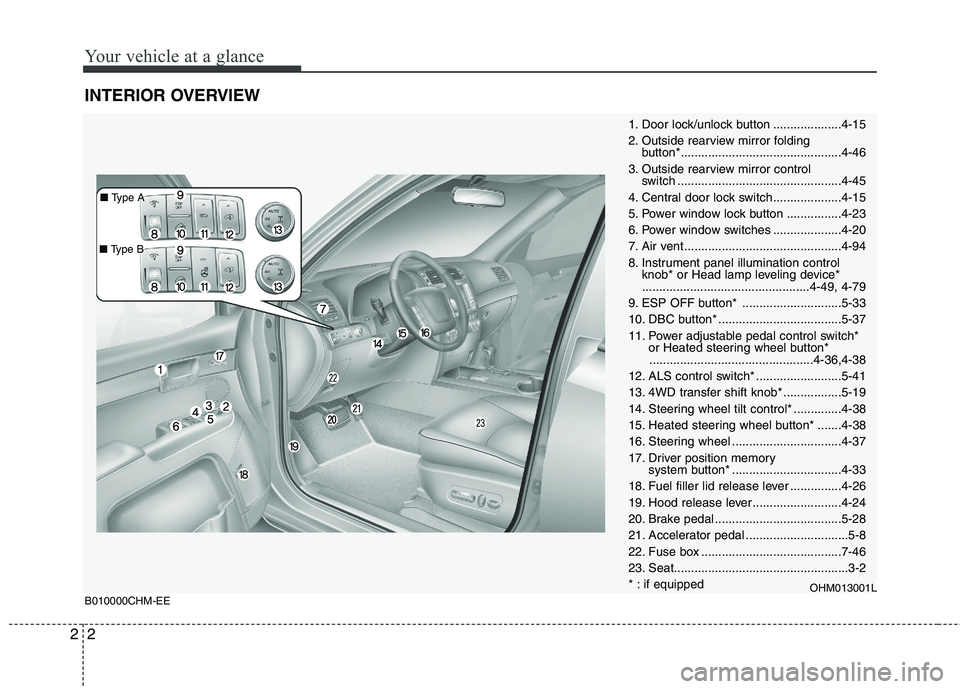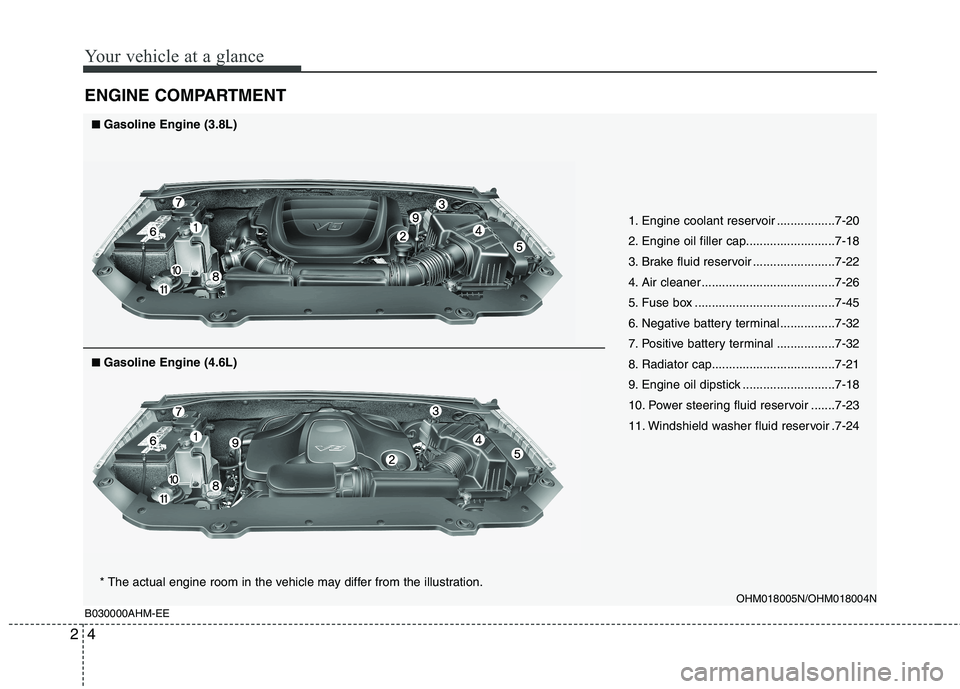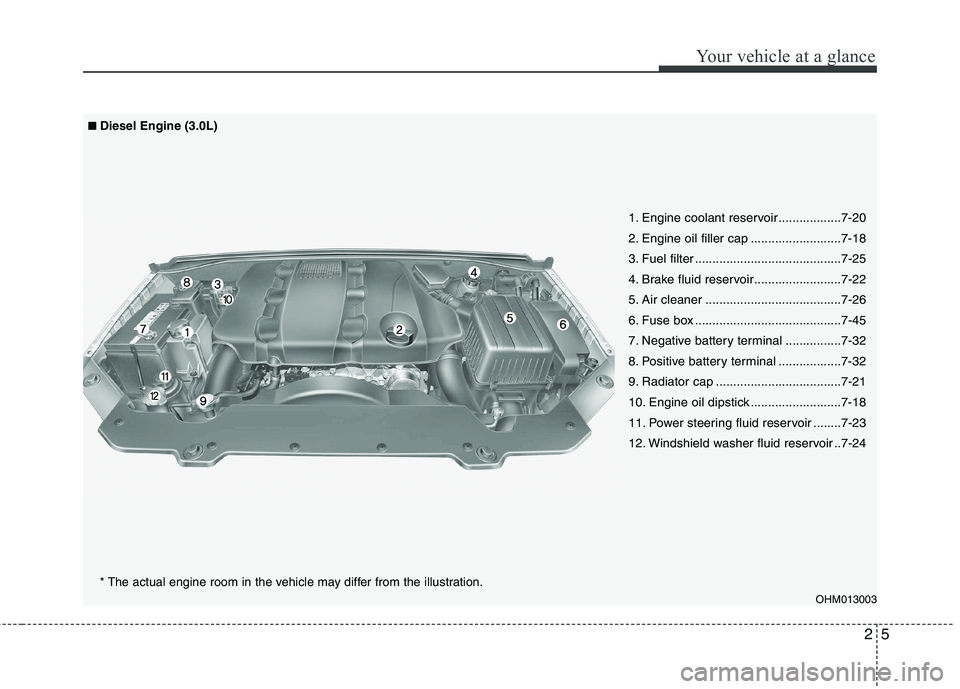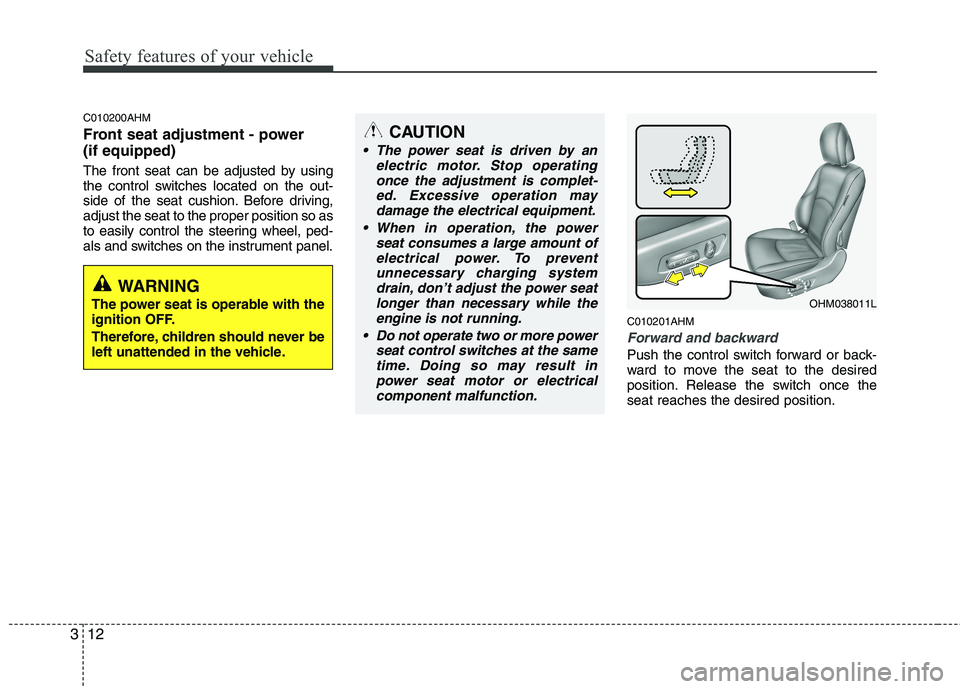power steering KIA BORREGO 2015 Owners Manual
[x] Cancel search | Manufacturer: KIA, Model Year: 2015, Model line: BORREGO, Model: KIA BORREGO 2015Pages: 420, PDF Size: 41.56 MB
Page 11 of 420

Your vehicle at a glance
2
2
INTERIOR OVERVIEW
1. Door lock/unlock button ....................4-15
2. Outside rearview mirror folding
button*...............................................4-46
3. Outside rearview mirror control switch ................................................4-45
4. Central door lock switch....................4-15
5. Power window lock button ................4-23
6. Power window switches ....................4-20
7. Air vent ..............................................4-94
8. Instrument panel illumination control knob* or Head lamp leveling device*.................................................4-49, 4-79
9. ESP OFF button* .............................5-33
10. DBC button* ....................................5-37
11. Power adjustable pedal control switch* or Heated steering wheel button*................................................4-36,4-38
12. ALS control switch* .........................5-41
13. 4WD transfer shift knob* .................5-19
14. Steering wheel tilt control* ..............4-38
15. Heated steering wheel button* .......4-38
16. Steering wheel ................................4-37
17. Driver position memory system button* ................................4-33
18. Fuel filler lid release lever ...............4-26
19. Hood release lever ..........................4-24
20. Brake pedal .....................................5-28
21. Accelerator pedal ..............................5-8
22. Fuse box .........................................7-46
23. Seat...................................................3-2
* : if equipped OHM013001L
B010000CHM-EE
■Type A
■ Type B
Page 12 of 420

23
Your vehicle at a glance
INSTRUMENT PANEL OVERVIEW
1. Instrument cluster.............................4-47
2. Steering wheel audio controls* ......4-129
3. Light control / Turn signals ...............4-75
4. Horn .................................................4-39
5. Auto cruise controls* ........................5-44
6. Wiper/Washer switch ........................4-81
7. Driver’s front air bag .........................3-48
8. Ignition switch* orENGINE START/STOP button* ...5-4, 5-6
9. Hazard warning flasher ......................6-2
10. Audio* ...........................................4-135
11. Digital clock ..................................4-123
12. Climate control system* .................4-90
13. Power outlet* ................................4-122
14. Cigar lighter and ashtray ..............4-120
15. Shift lever .......................................5-12
16. AUX, USB and iPod port*.............4-132
17. Front seat warmer/Seat air ventilation switch ...............................................3-9
18. Rear parking assist system OFF switch* ....................................4-67
19. Rear fog light switch* .....................4-79
20. Parking brake pedal .......................5-29
21. Brake pedal ....................................5-28
22. Accelerator pedal .............................5-8
23. Passenger’s front air bag* ..............3-48
24. Glove box .....................................4-117
* : if equipped OHM018002L
B020000CHM-EE
Page 13 of 420

Your vehicle at a glance
4
2
ENGINE COMPARTMENT
B030000AHM-EE
1. Engine coolant reservoir .................7-20
2. Engine oil filler cap..........................7-18
3. Brake fluid reservoir ........................7-22
4. Air cleaner .......................................7-26
5. Fuse box .........................................7-45
6. Negative battery terminal ................7-32
7. Positive battery terminal .................7-32
8. Radiator cap....................................7-21
9. Engine oil dipstick ...........................7-18
10. Power steering fluid reservoir .......7-23
11. Windshield washer fluid reservoir .7-24 OHM018005N/OHM018004N
* The actual engine room in the vehicle may differ from the illustration.
■
■
Gasoline Engine (3.8L)
■■Gasoline Engine (4.6L)
Page 14 of 420

25
Your vehicle at a glance
OHM013003
1. Engine coolant reservoir ..................7-20
2. Engine oil filler cap ..........................7-18
3. Fuel filter ..........................................7-25
4. Brake fluid reservoir.........................7-22
5. Air cleaner .......................................7-26
6. Fuse box ..........................................7-45
7. Negative battery terminal ................7-32
8. Positive battery terminal ..................7-32
9. Radiator cap ....................................7-21
10. Engine oil dipstick ..........................7-18
11. Power steering fluid reservoir ........7-23
12. Windshield washer fluid reservoir ..7-24
■■Diesel Engine (3.0L)
* The actual engine room in the vehicle may differ from the illustration.
Page 26 of 420

Safety features of your vehicle
12
3
C010200AHM
Front seat adjustment - power (if equipped)
The front seat can be adjusted by using
the control switches located on the out-
side of the seat cushion. Before driving,adjust the seat to the proper position so as
to easily control the steering wheel, ped-
als and switches on the instrument panel.
C010201AHM
Forward and backward
Push the control switch forward or back-
ward to move the seat to the desired
position. Release the switch once theseat reaches the desired position.
OHM038011L
CAUTION
The power seat is driven by anelectric motor. Stop operating
once the adjustment is complet-ed. Excessive operation maydamage the electrical equipment.
When in operation, the power seat consumes a large amount ofelectrical power. To preventunnecessary charging systemdrain, don’t adjust the power seat
longer than necessary while the engine is not running.
Do not operate two or more power seat control switches at the sametime. Doing so may result in
power seat motor or electricalcomponent malfunction.
WARNING
The power seat is operable with the
ignition OFF.
Therefore, children should never be
left unattended in the vehicle.
Page 75 of 420

4
Keys / 4-3
Smart key / 4-6
Remote keyless entry / 4-9
Theft-alarm system / 4-12
Door locks / 4-14
Tailgate / 4-18
Windows / 4-20
Hood / 4-24
Fuel filler lid / 4-26
Sunroof / 4-29
Driver position memory system / 4-33
Power adjustable pedals / 4-36
Steering wheel / 4-37
Mirrors / 4-40
Instrument cluster / 4-47
Rear parking assist system / 4-67
Parking assist system / 4-70
Rearview camera / 4-74
Hazard warning flasher / 4-74
Lighting / 4-75
Wipers and washers / 4-81
Interior light / 4-85
Welcome system / 4-88
Features of your vehicle
Page 111 of 420

437
Features of your vehicle
D130100AHM
Power steering
Power steering uses energy from the
engine to assist you in steering the vehi-
cle. If the engine is off or if the power
steering system becomes inoperative,
the vehicle may still be steered, but it will
require increased steering effort.
Should you notice any change in the
effort required to steer during normal
vehicle operation, have the power steer-
ing checked by an authorized Kia dealer.✽✽NOTICE
If the power steering drive belt breaks
or if the power steering pump malfunc-
tions, the steering effort will greatly
increase.
✽
✽ NOTICE
If the vehicle is parked for extended
periods outside in cold weather (below
-10°C(14°F)), the power steering may
require increased effort when the engine
is first started. This is caused by
increased fluid viscosity due to the cold
weather and does not indicate a mal-
function.
When this happens, increase the engine
RPM by depressing the accelerator until
the RPM reaches 1,500 rpm then release
or let the engine idle for two or three
minutes to warm up the fluid.
D130300AEN Tilt steering
Tilt steering allows you to adjust the
steering wheel before you drive. You can
also raise it to give your legs more room
when you exit and enter the vehicle.
The steering wheel should be positioned
so that it is comfortable for you to drive,
while permitting you to see the instru-
ment panel warning lights and gauges.
STEERING WHEEL
CAUTION
Never hold the steering wheel to the
extreme right or left for more than 5
seconds with the engine running.Holding the steering wheel for morethan 5 seconds in either positionmay cause damage to the power
steering pump.
WARNING
Never adjust the angle of the steering wheel while driving. You
may lose steering control and
cause severe personal injury,death or accidents.
After adjusting, push the steering wheel both up and down to be
certain it is locked in position.
Page 197 of 420

4123
Features of your vehicle
The power outlet is designed to provide
power for mobile telephones or other
devices designed to operate with vehicle
electrical systems. The devices should
draw less than 10 amps with the engine
running.D280600AEN
Digital clock
Whenever the battery terminals or relat-
ed fuses are disconnected, you must
reset the time.
When the ignition switch is in the ACC or
ON position, the clock buttons operate as
follows:D280601BHM
Hour (1)
Press the H button to advance the time
displayed by one hour.
Hold the H button to advance the hour
reading more rapildy.
WARNING
Do not adjust the clock while driv-
ing. You may lose your steering
control and cause an accident that
results in severe personal injury ordeath.
CAUTION
Use the power outlet only when the engine is running and removethe accessory plug after use.Using the accessory plug for pro-
longed periods of time with the engine off could cause the bat-tery to discharge.
Only use 12V electric accessories which are less than 10A in elec-
tric capacity.
Adjust the air-conditioner or heater to the lowest operatinglevel when using the power outlet.
Close the cover when not in use. Some electronic devices can cause electronic interferencewhen plugged into a vehicle’spower outlet. These devices may cause excessive audio static and
malfunctions in other electronicsystems or devices used in yourvehicle.
WARNING
Do not put a finger or a foreign ele-
ment (pin, etc.) into a power outlet
and do not touch with a wet hand.
You may get an electric shock.
OHM048137
OHM048136
■ Type A
■ Type B
Page 248 of 420

Driving your vehicle
6
5
Illuminated ENGINE START/STOP
button E030100AHM
Whenever the front door is opened, the
ENGINE START/STOP button will illumi-
nate for your convenience. The light willgo off after about 30 seconds when the
door is closed. It will also go off immedi-
ately when the theft-alarm system is
armed. ENGINE START/STOP button position E030701AHM
OFF
To turn off the engine (START/RUN posi-
tion) or vehicle power (ON position),
press the ENGINE START/STOP button
with the shift lever in the P (Park) posi-
tion. When you press the ENGINE
START/STOP button without the shift
lever in the P (Park) position, the
ENGINE START/STOP button will not
changed to the OFF position but to the
ACC position.
Also, the steering wheel locks when the
ENGINE START/STOP button is in the
OFF position to protect you against theft.
It locks when the door is opened or when
you pull out the smart key from the smart
key holder.
If the steering wheel is not locked prop-
erly when you open the driver's door, the
warning chime will sound. Try locking the
steering wheel again. If the problem is
not solved, have it checked by an author-
ized Kia dealer.In addition, if the ENGINE START/STOP
button is in the OFF position after the dri-
ver's door is opened, the steering wheel
will not lock and the warning chime will
sound. In such a situation, close the door.
Then the steering wheel will lock and the
warning chime will stop.
✽✽
NOTICE
If the steering wheel doesn't unlock
properly, the ENGINE START/STOP
button will not work. Press the ENGINE
START/STOP button while turning the
steering wheel right and left to release
the tension.
ENGINE START/STOP BUTTON (IF EQUIPPED)
OHM058001
CAUTION
You are able to turn off the engine (START/RUN) or vehicle power (ON), only when the vehicle is not in
motion. In an emergency situationwhile the vehicle is in motion, you are able to turn the engine off and to theACC position by pressing the ENGINE
START/STOP button for more than 2 seconds or 3 times successively within 3 seconds. If the vehicle is stillmoving, you can restart the engine
without depressing the brake pedalby pressing the ENGINE START/STOP button with the shift lever in the N(Neutral) position.
Not illuminated
Page 260 of 420

Driving your vehicle
18
5
FOUR WHEEL DRIVE (4WD) (IF EQUIPPED)
E170000AHM
Engine power can be delivered to all front
and rear wheels for maximum traction.
4WD is useful when extra traction is
required on road, such as, when driving
on slippery, muddy, wet, or snow-covered
roads. These vehicles are not designed
for challenging off-road use. Occasional
off-road use such as established
unpaved roads and trails are OK. It is
always important when traveling off-high-
way that the driver carefully reduces the
speed to a level that does not exceed the
safe operating speed for those condi-
tions. In general, off-road conditions pro-
vide less traction and braking effective-
ness than normal road conditions. The
driver must be especially alert to avoid
driving on slopes which tilt the vehicle to
either side.
These factors must be carefully consid-
ered when driving off-road. Keeping the
vehicle in contact with the driving surfaceand under control in these conditions is
always the driver's responsibility for the
safety of him/herself and his or her pas-
sengers. E170201AHM
Tight corner brake effect
Tight corner brake effect is a unique
characteristic of four-wheel drive vehicles
caused by the difference in tire rotation at
the four wheels and the zero-degreealignment of the front wheels and sus-pension.
Sharp turns at low speeds should be car-
ried out with caution.
WARNING
- Off road driving
This vehicle is designed primarily
for on road use although it can oper-
ate effectively off road. However, it
was not designed to drive in chal-
lenging off-road conditions. Driving
in conditions that exceed the vehi-
cle's intended design or the driver's
experience level may result in
severe injury or death.
CAUTION - 4WD
When turning sharply on a paved
road at low speed while in four-wheel drive (4L mode for full-time 4WD operation or 4L/4H mode for
part-time 4WD operation), steering control will be difficult.
CAUTION
Do not select four wheel drive on flat and normal roads.
Four-wheel driving on flat roads for a long period causes poor fueleconomy and noise and it alsocauses tires to wear faster.
Four-wheel driving on flat and normal roads can result in asevere binding and chatteringcondition when turning the steer- ing wheel.
Four-wheel driving on flat roads for a long period can also causethe differential oil temperature to increase, resulting in damage toparts in the power train.